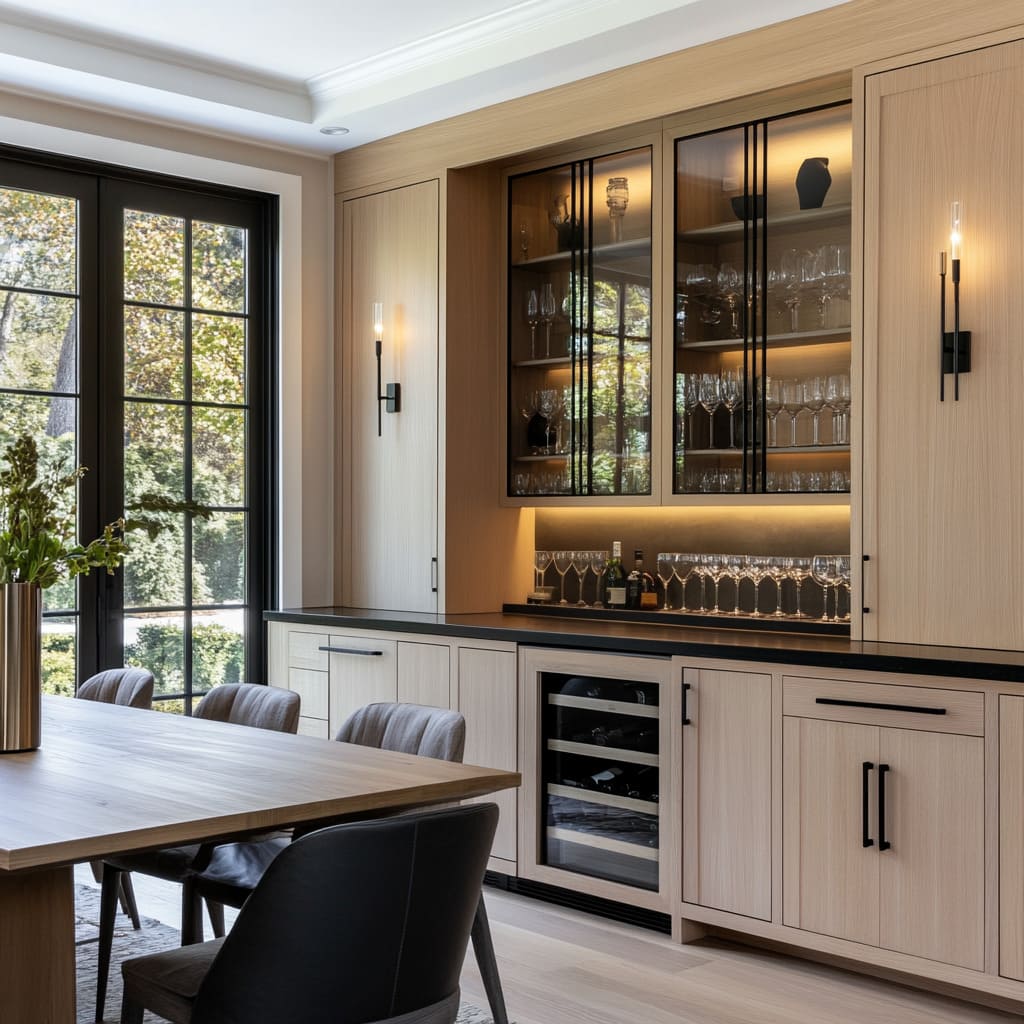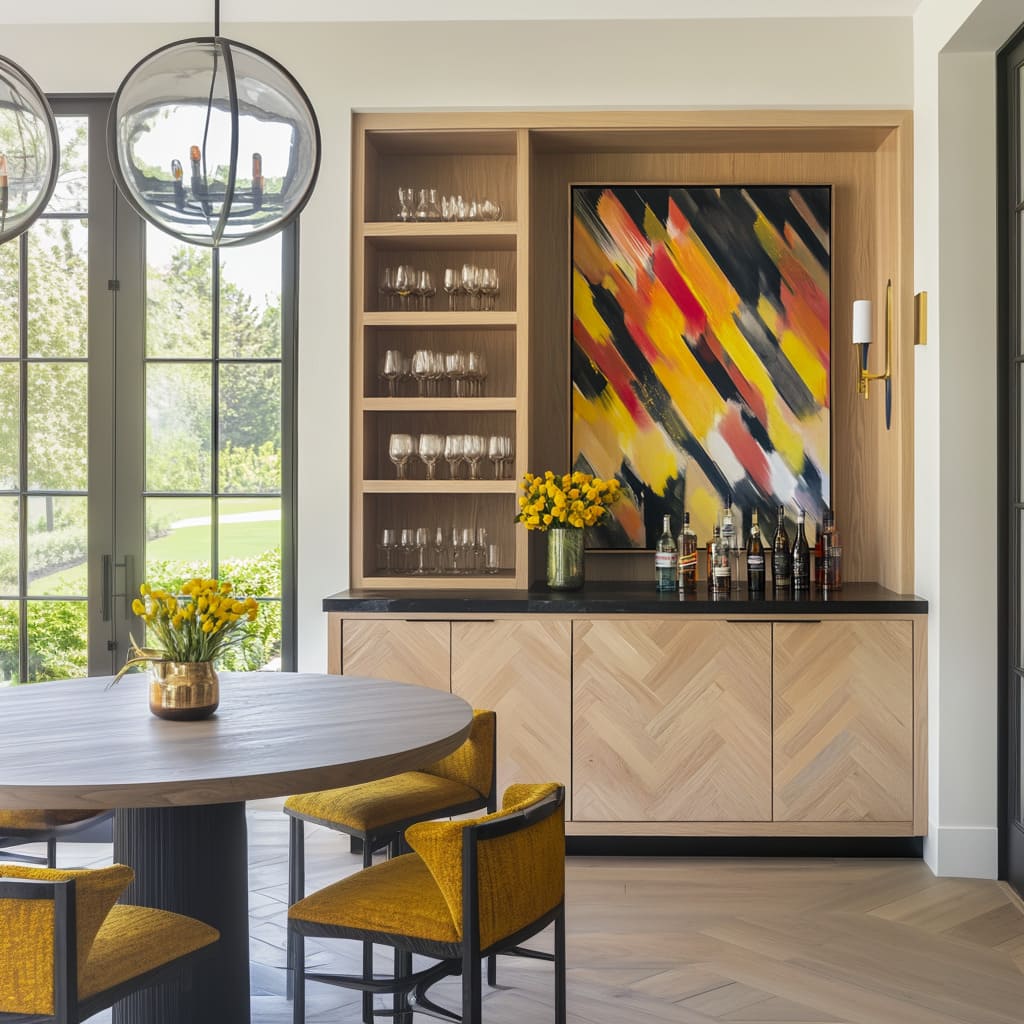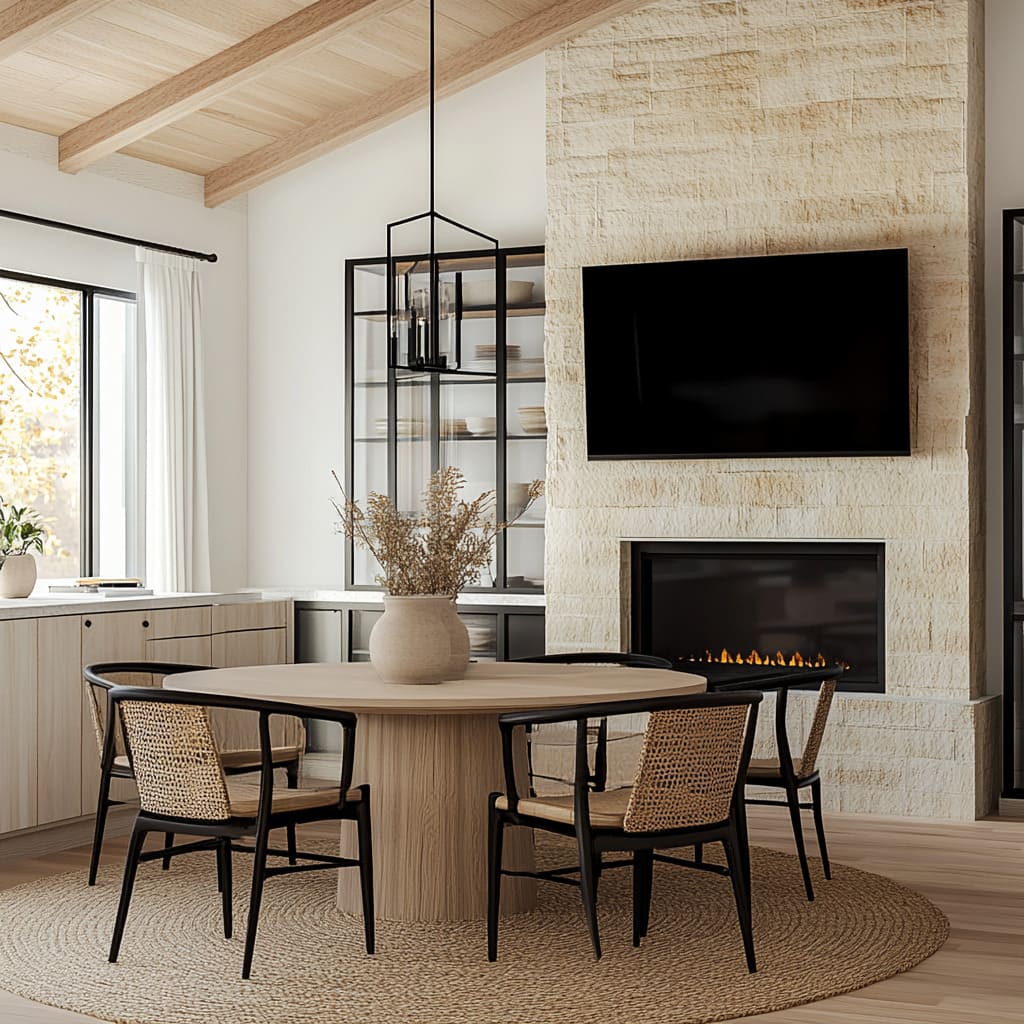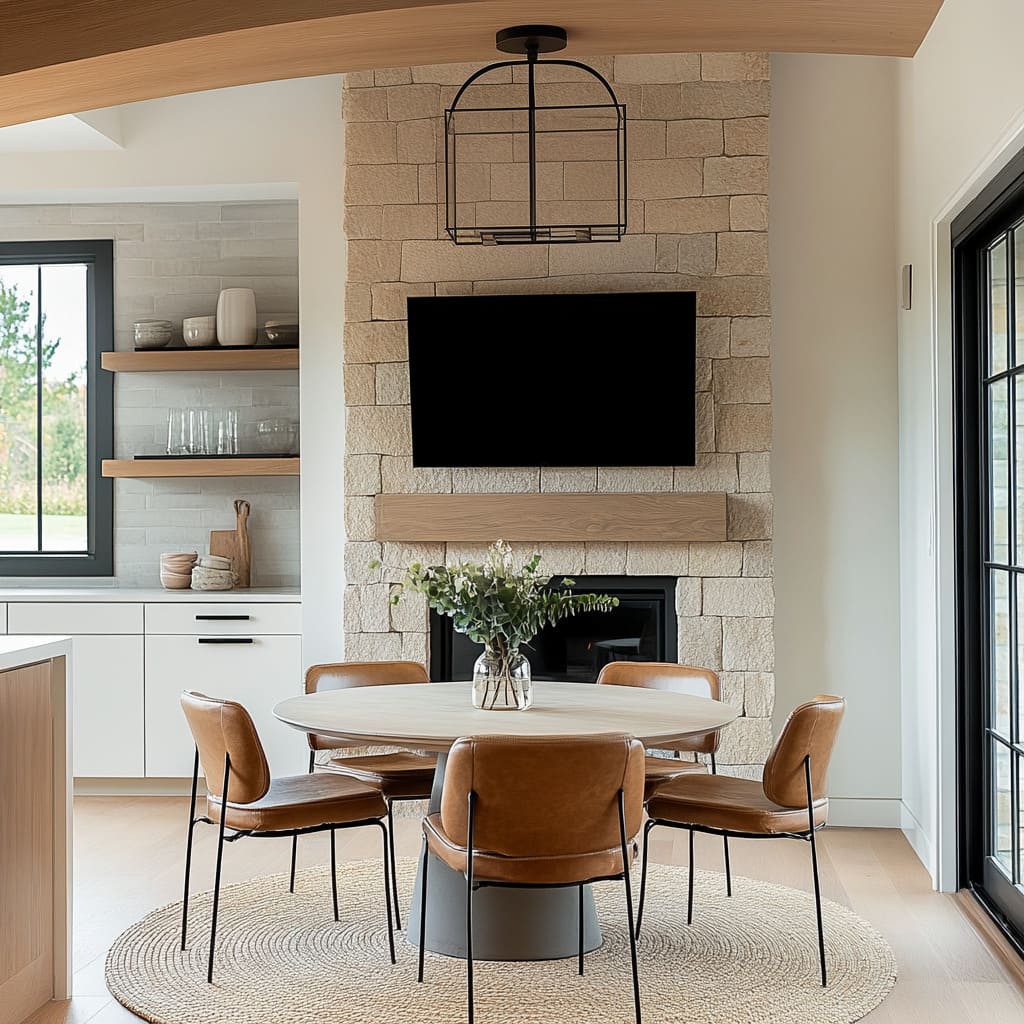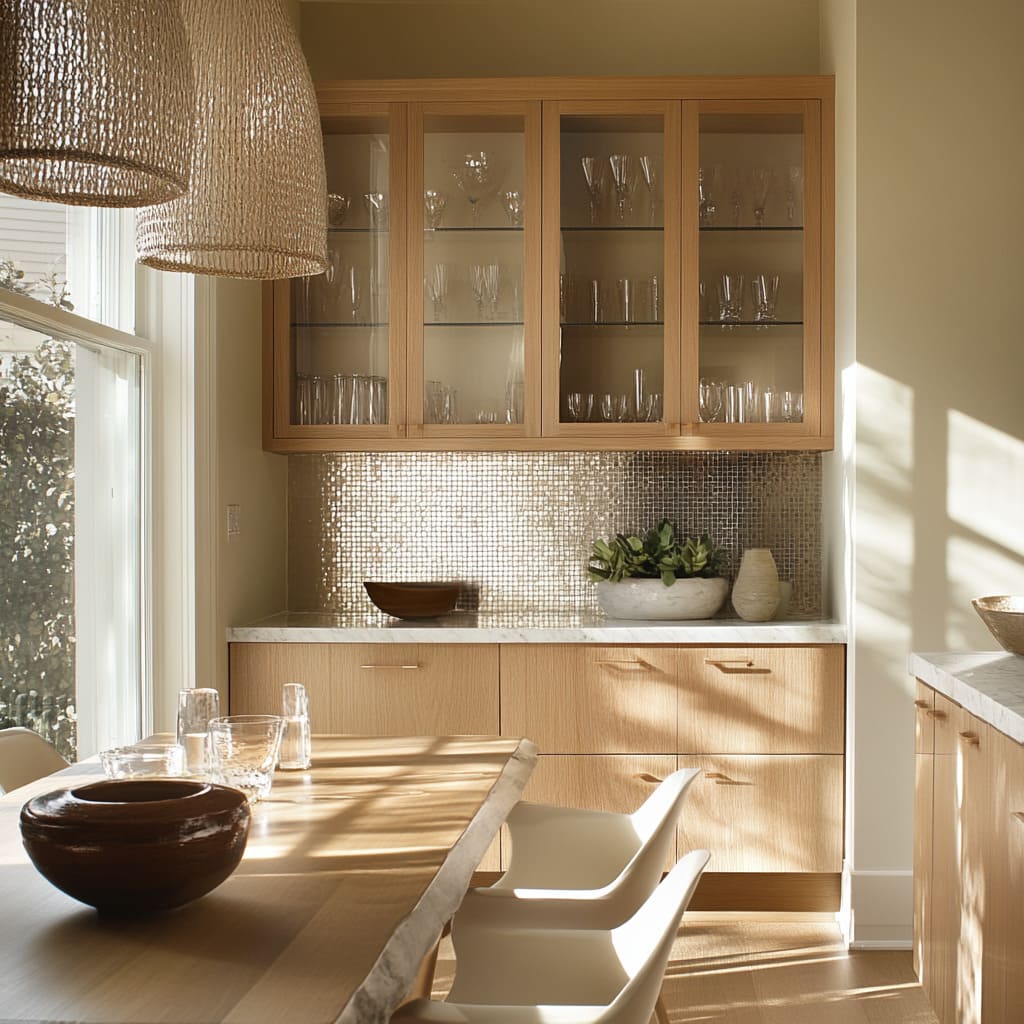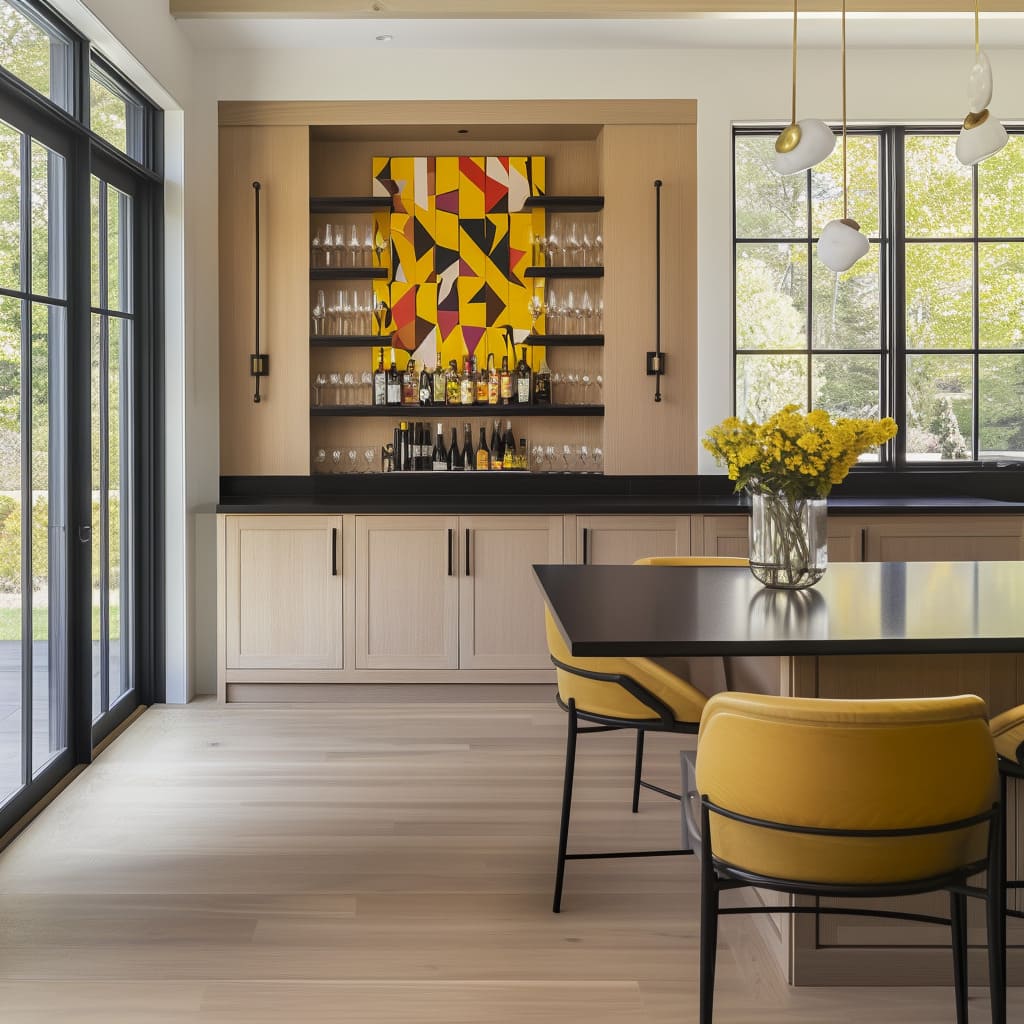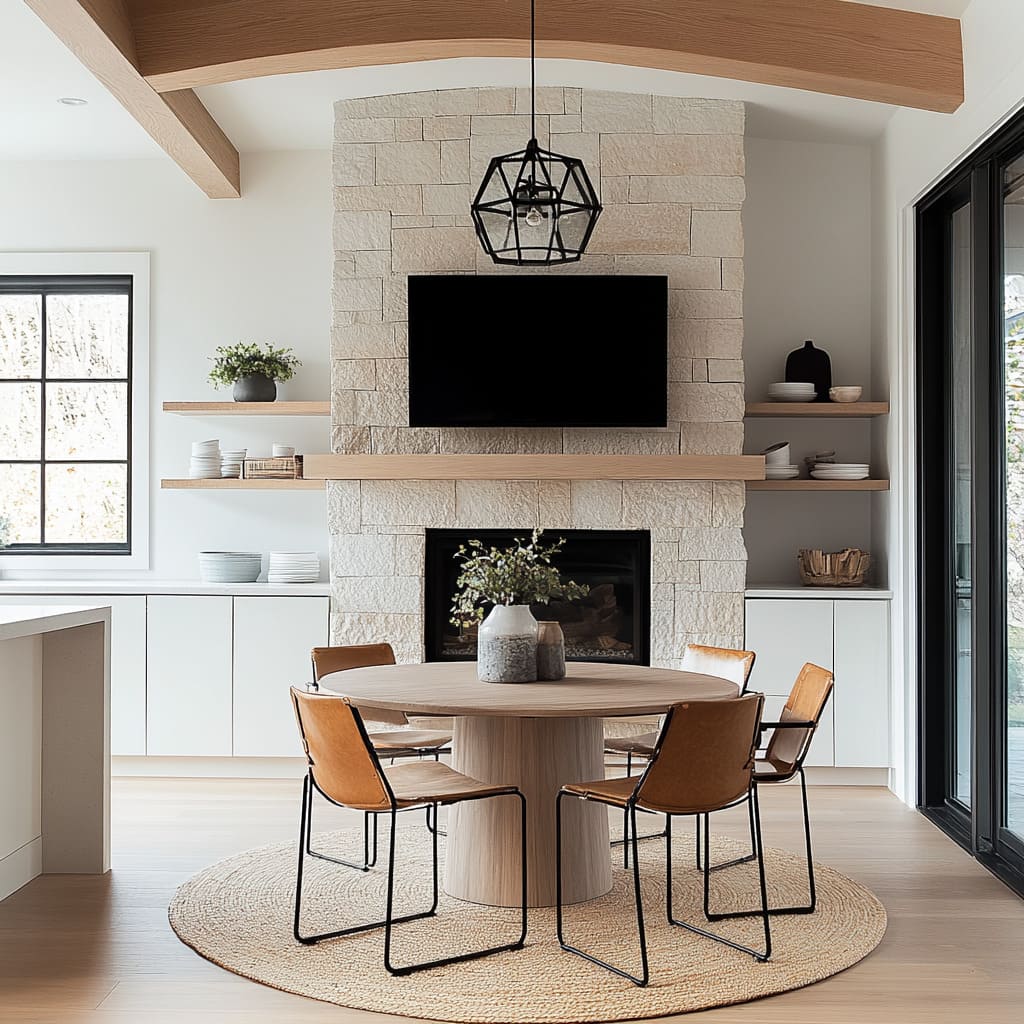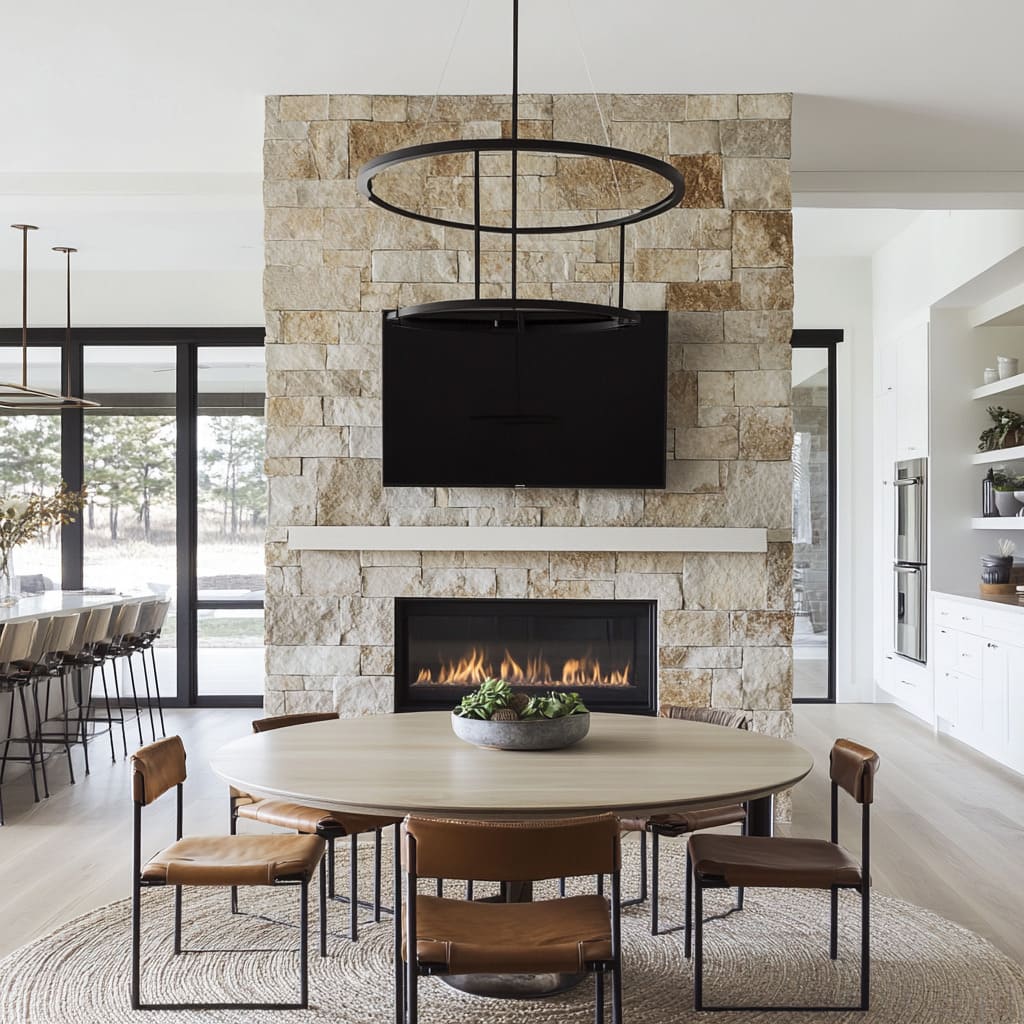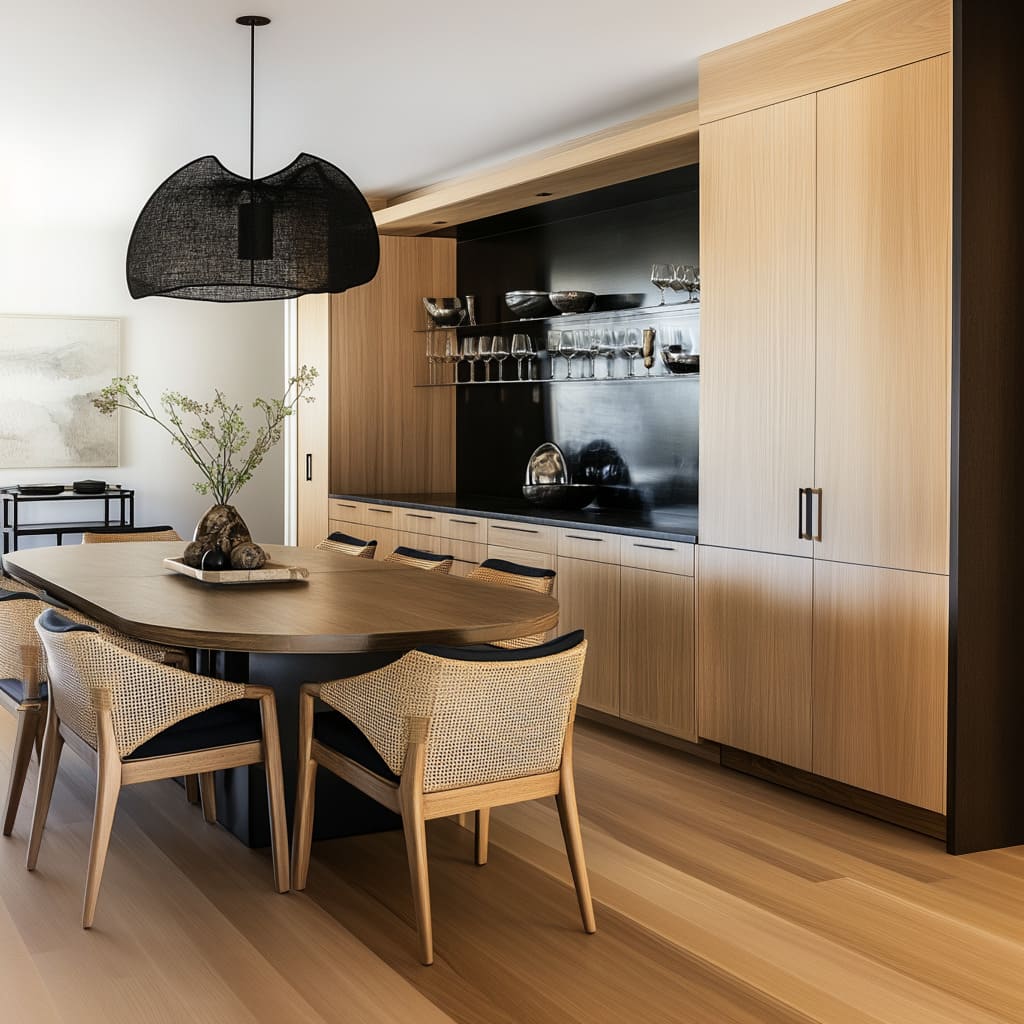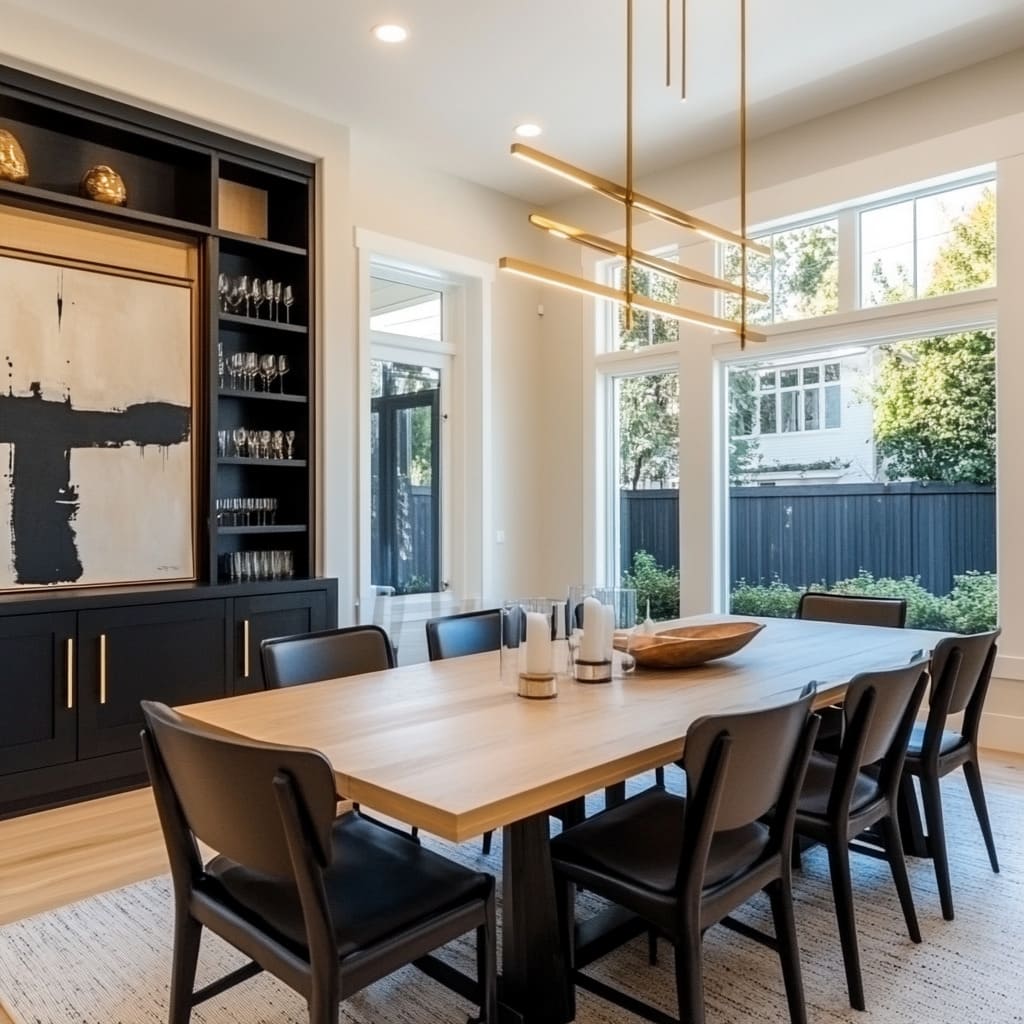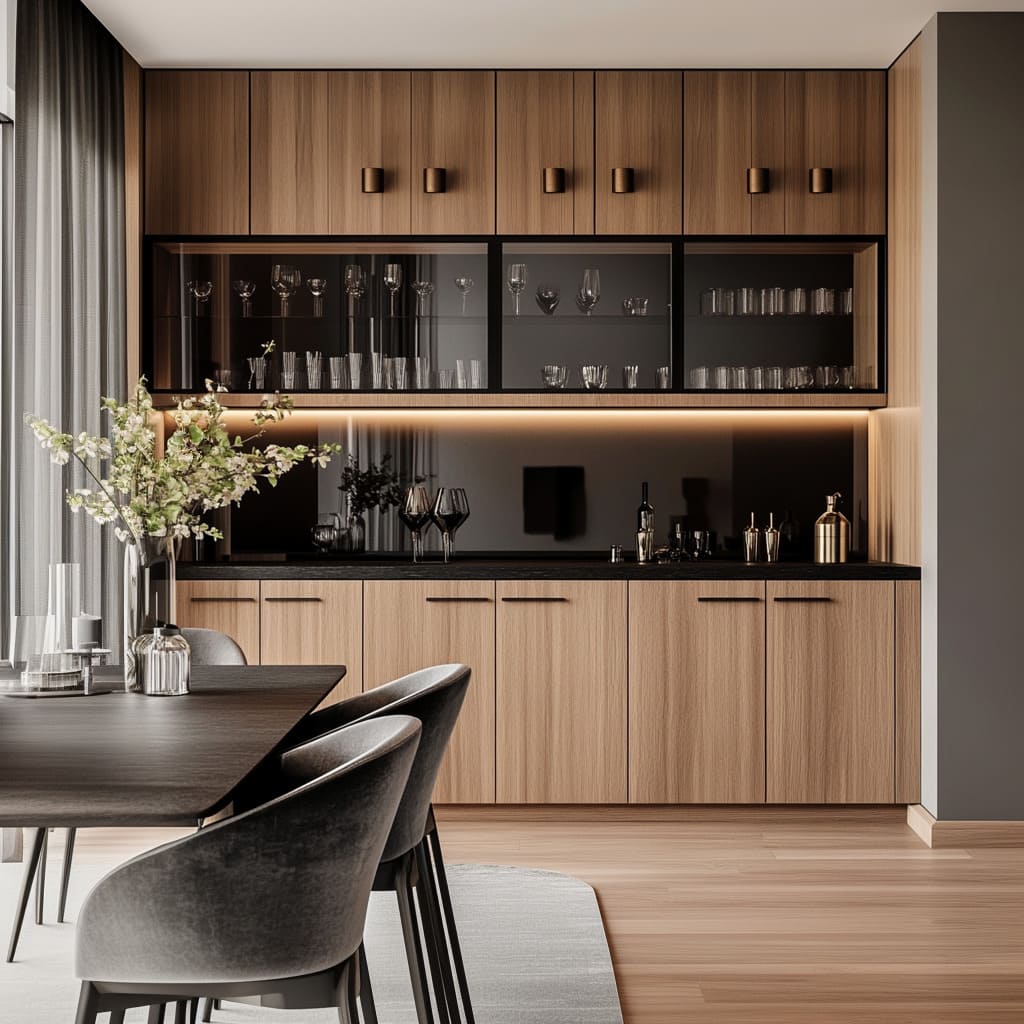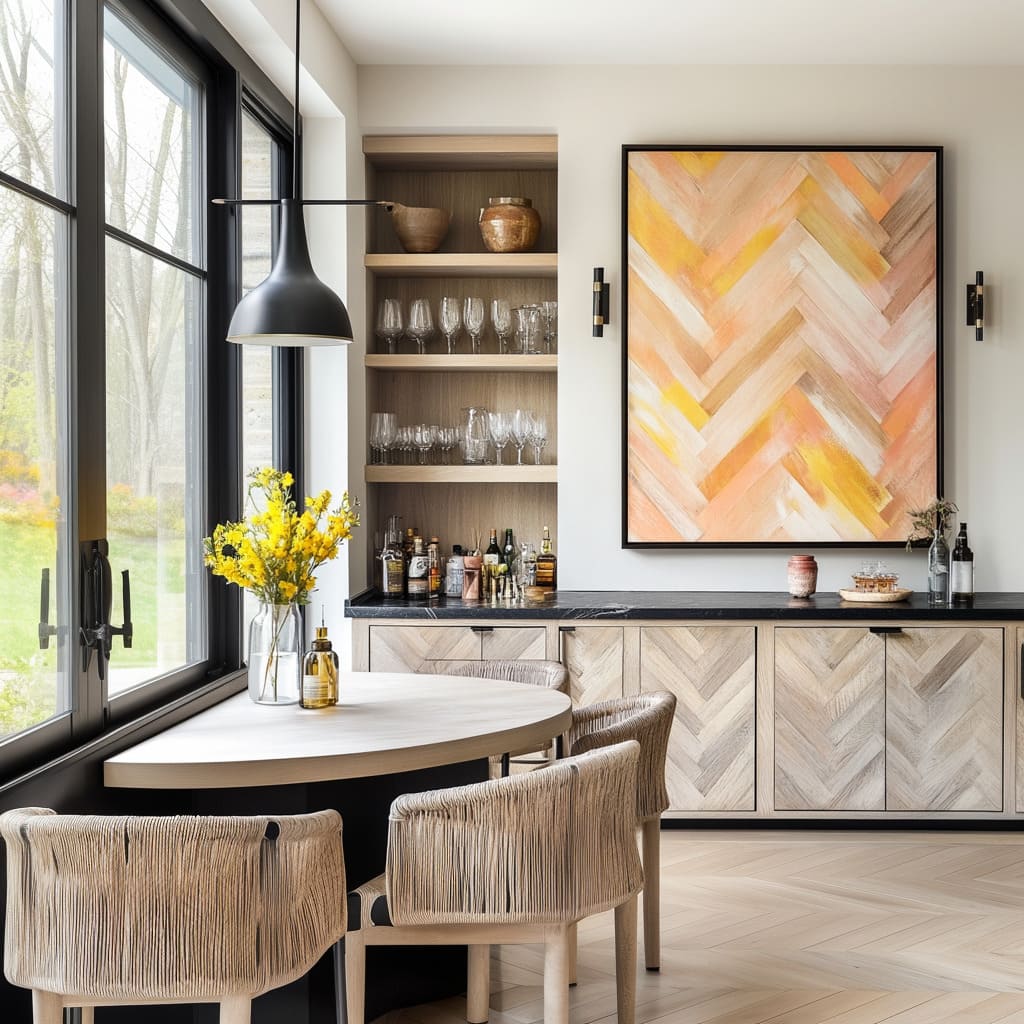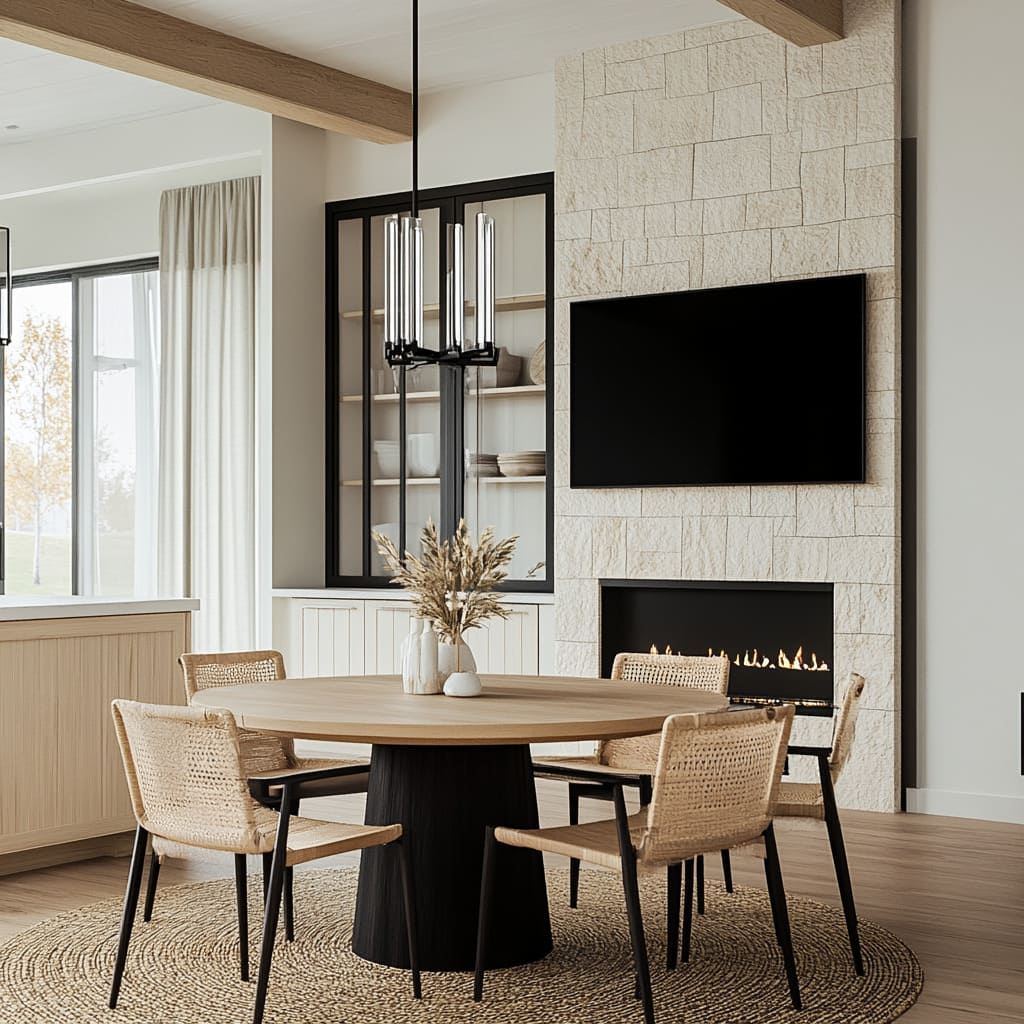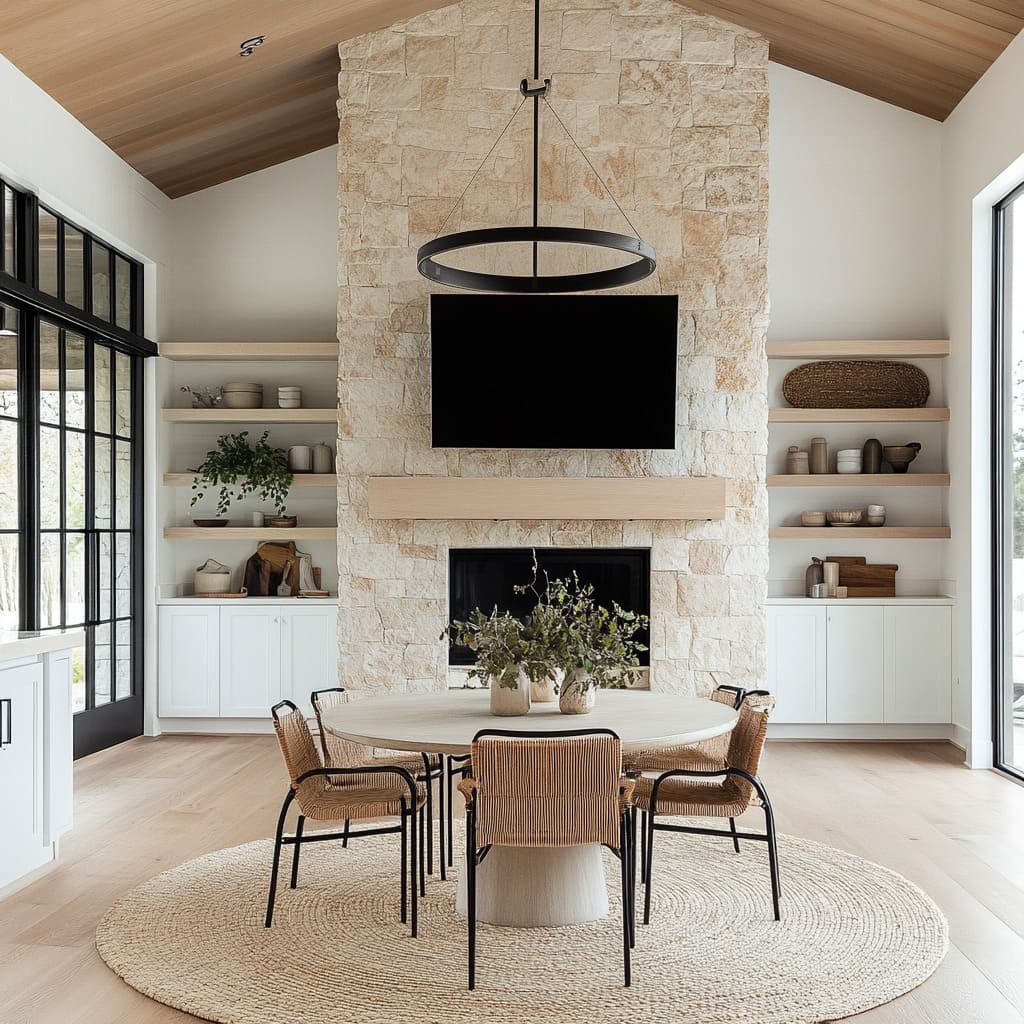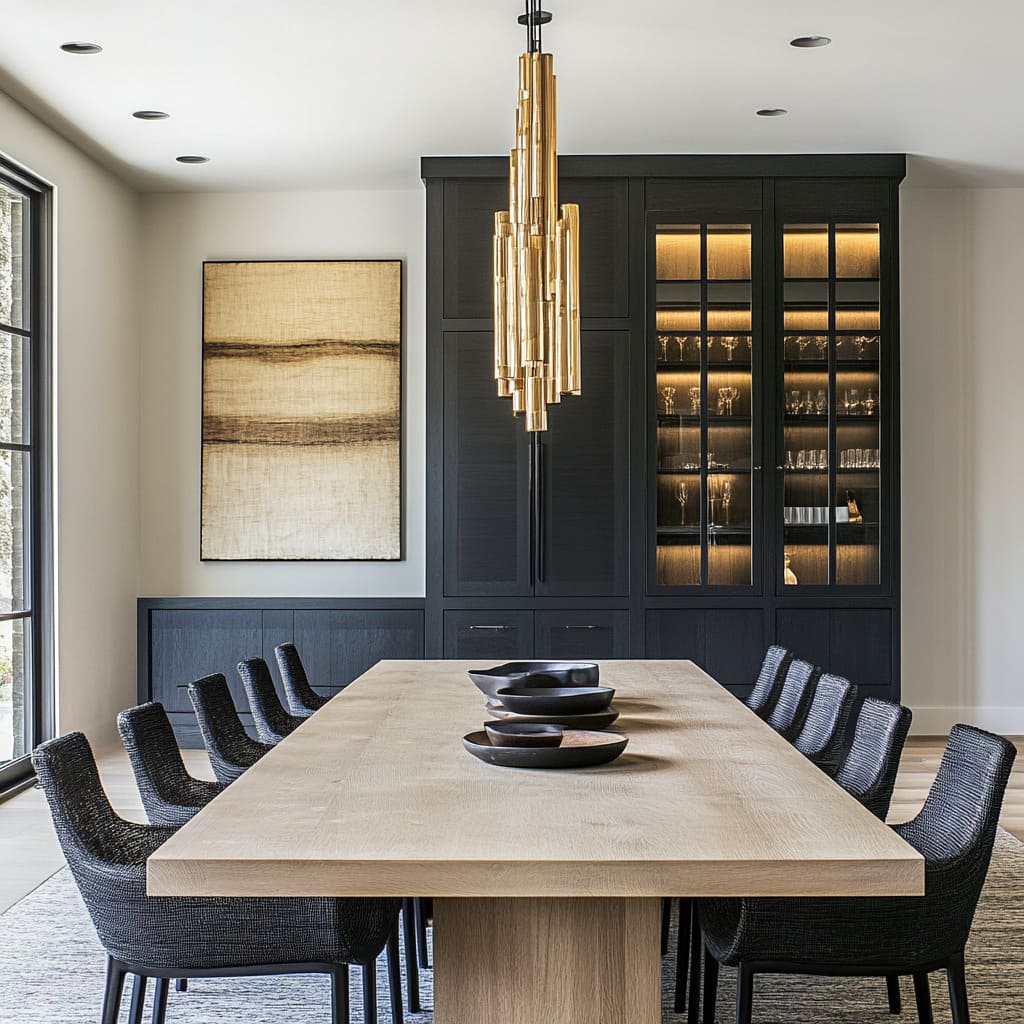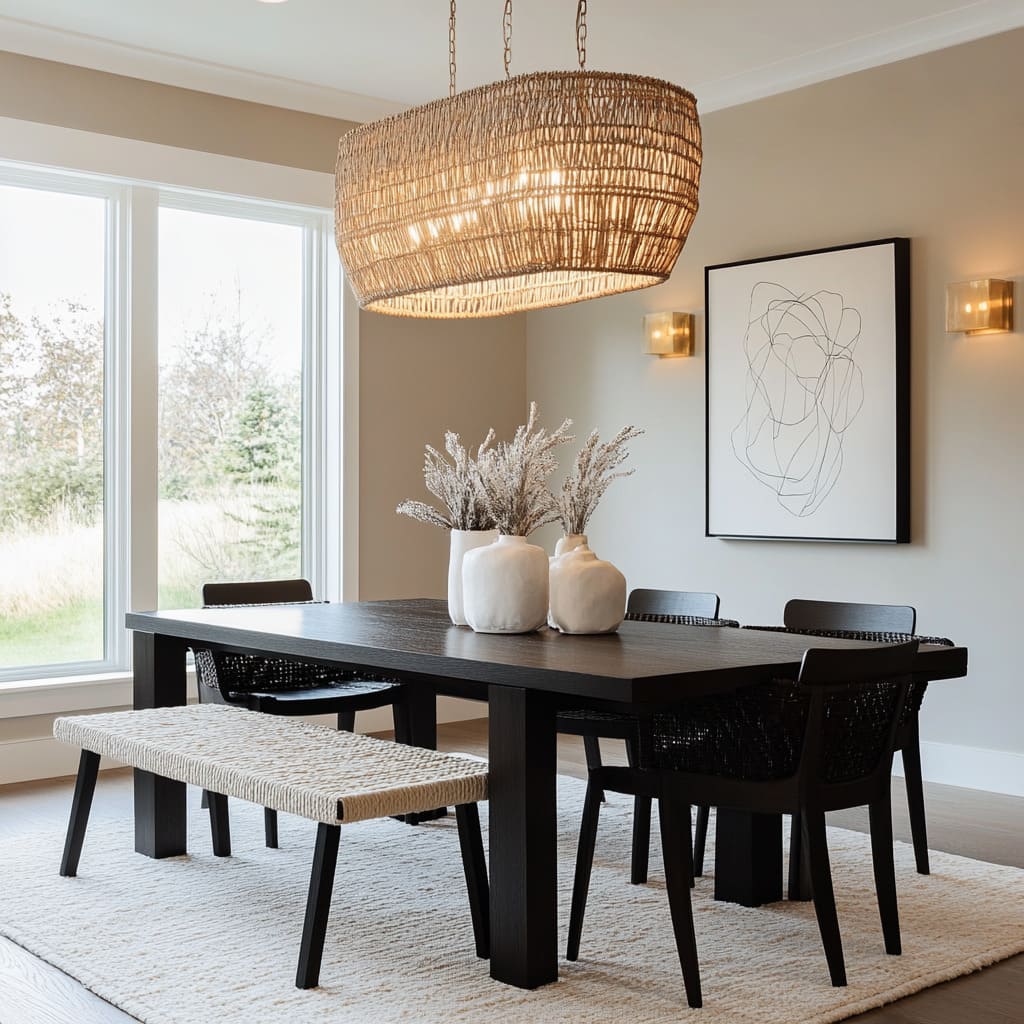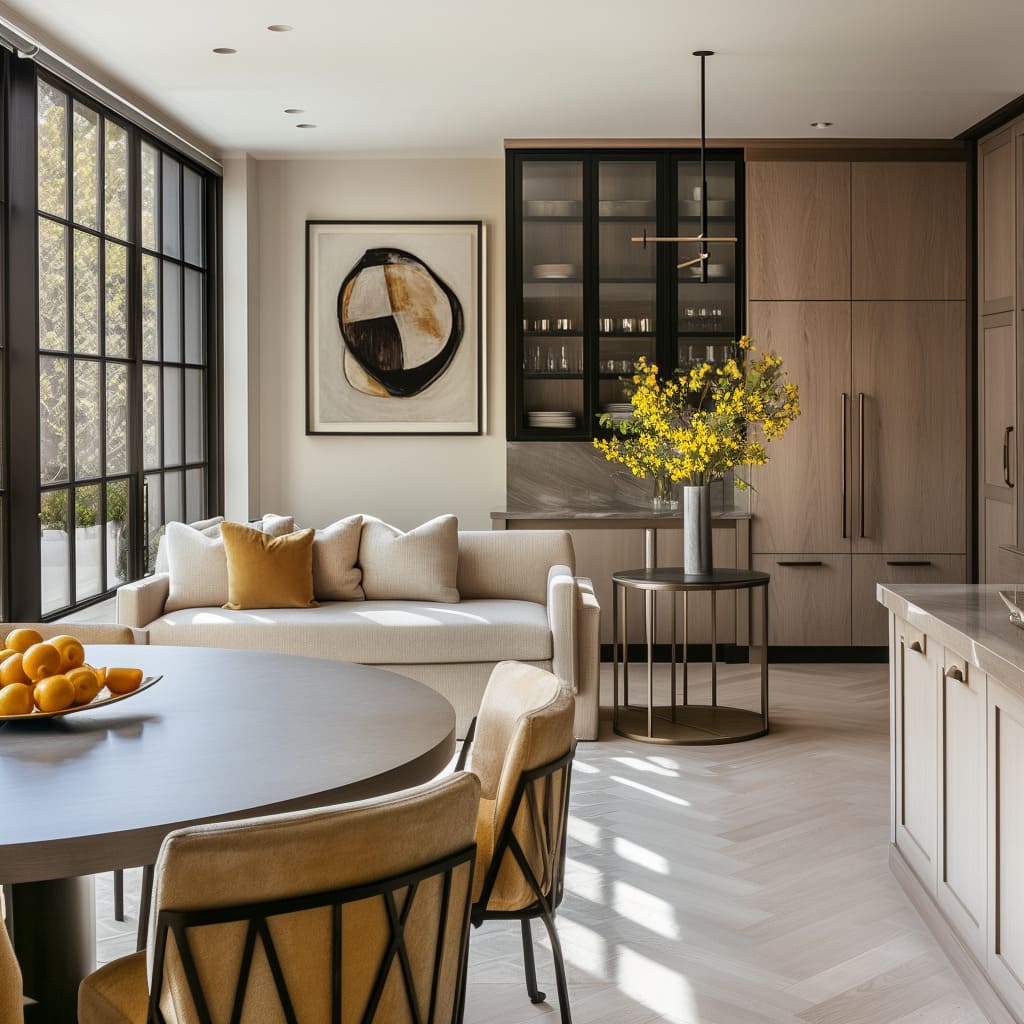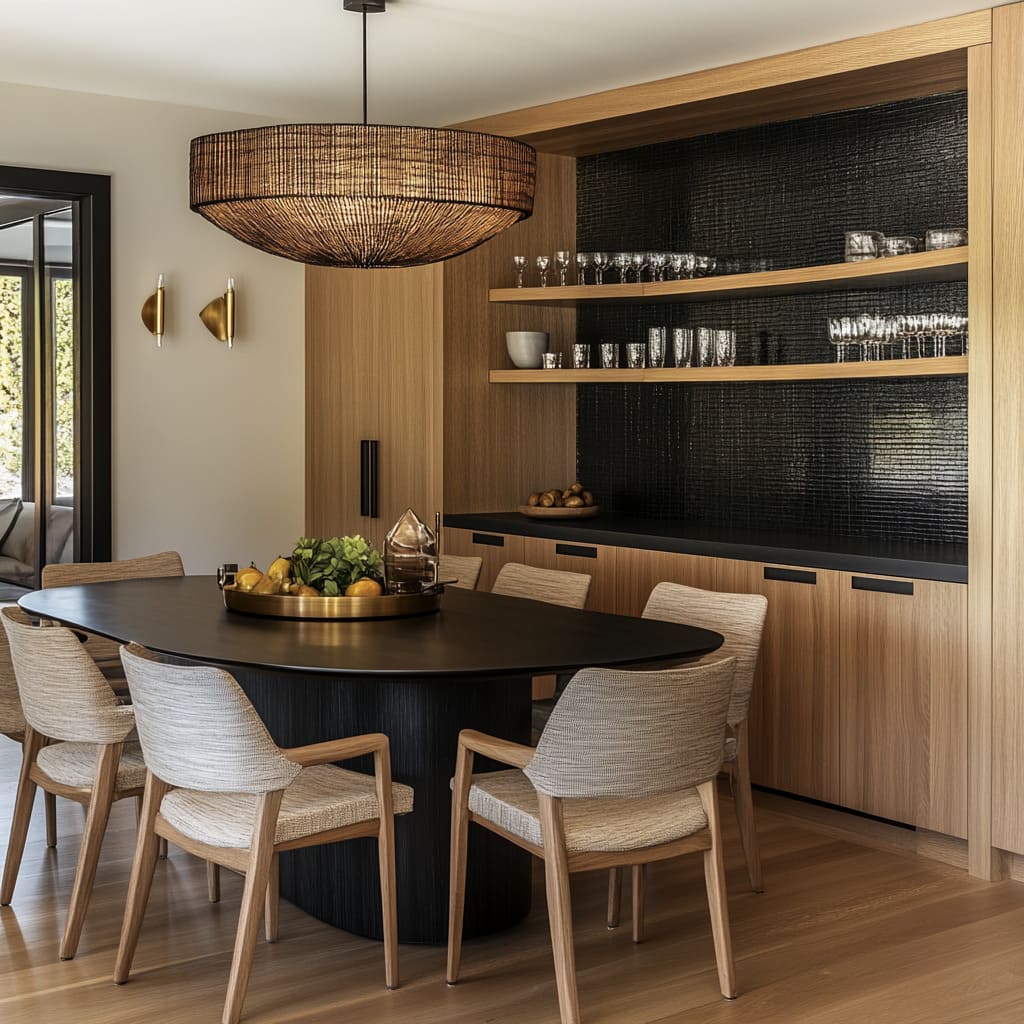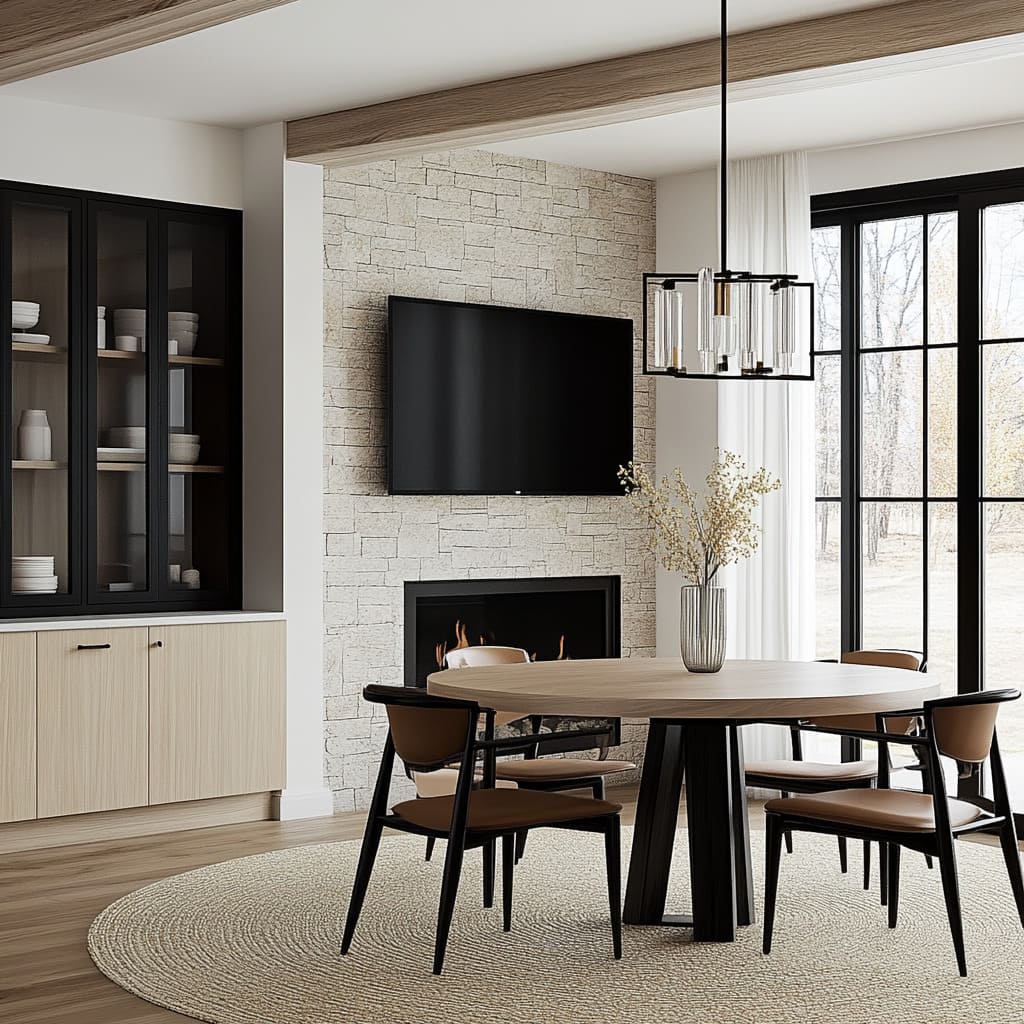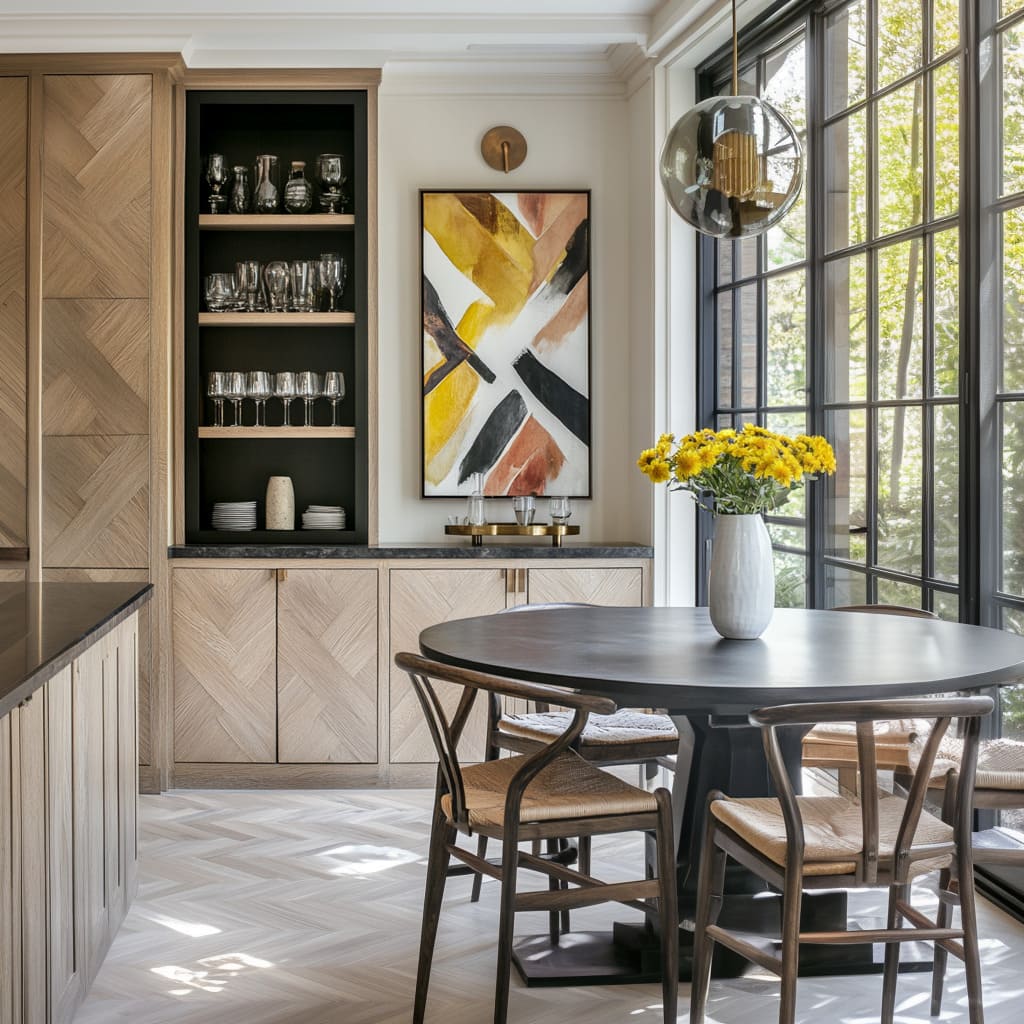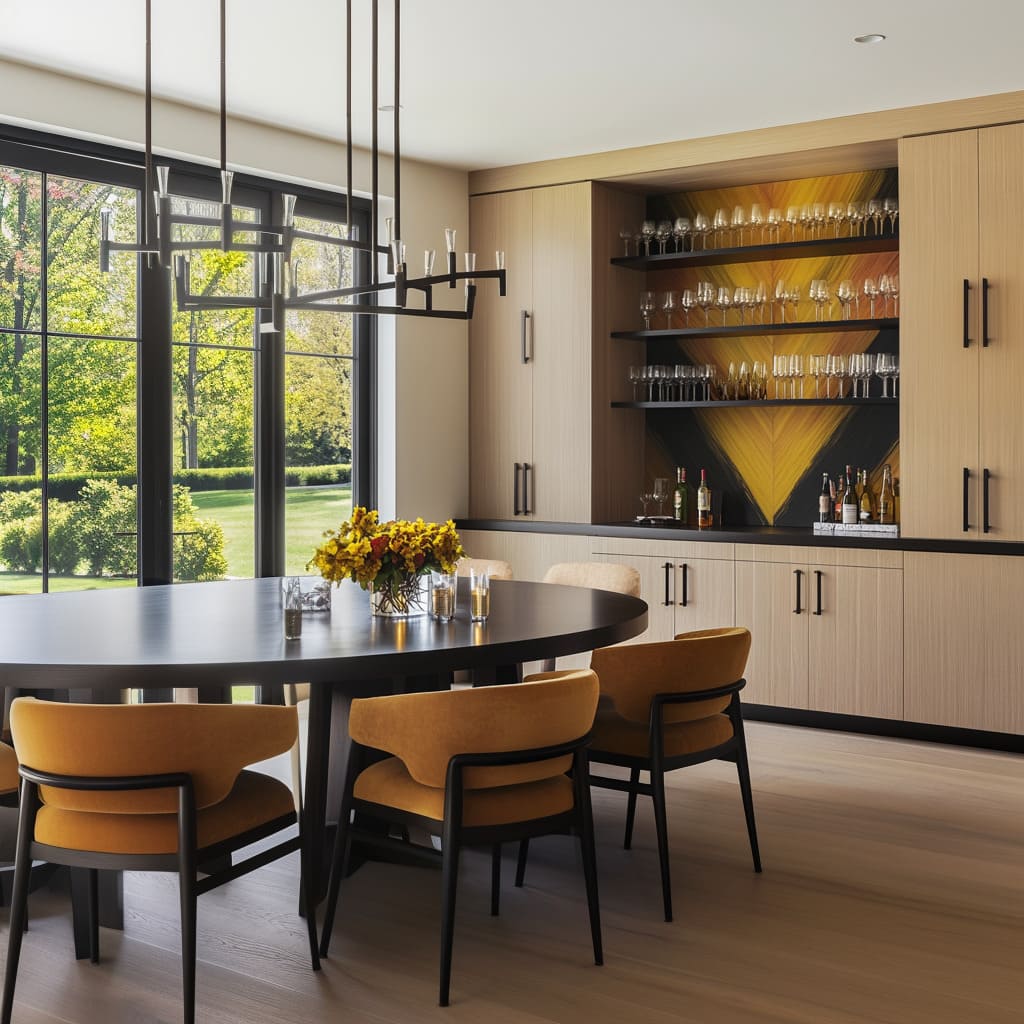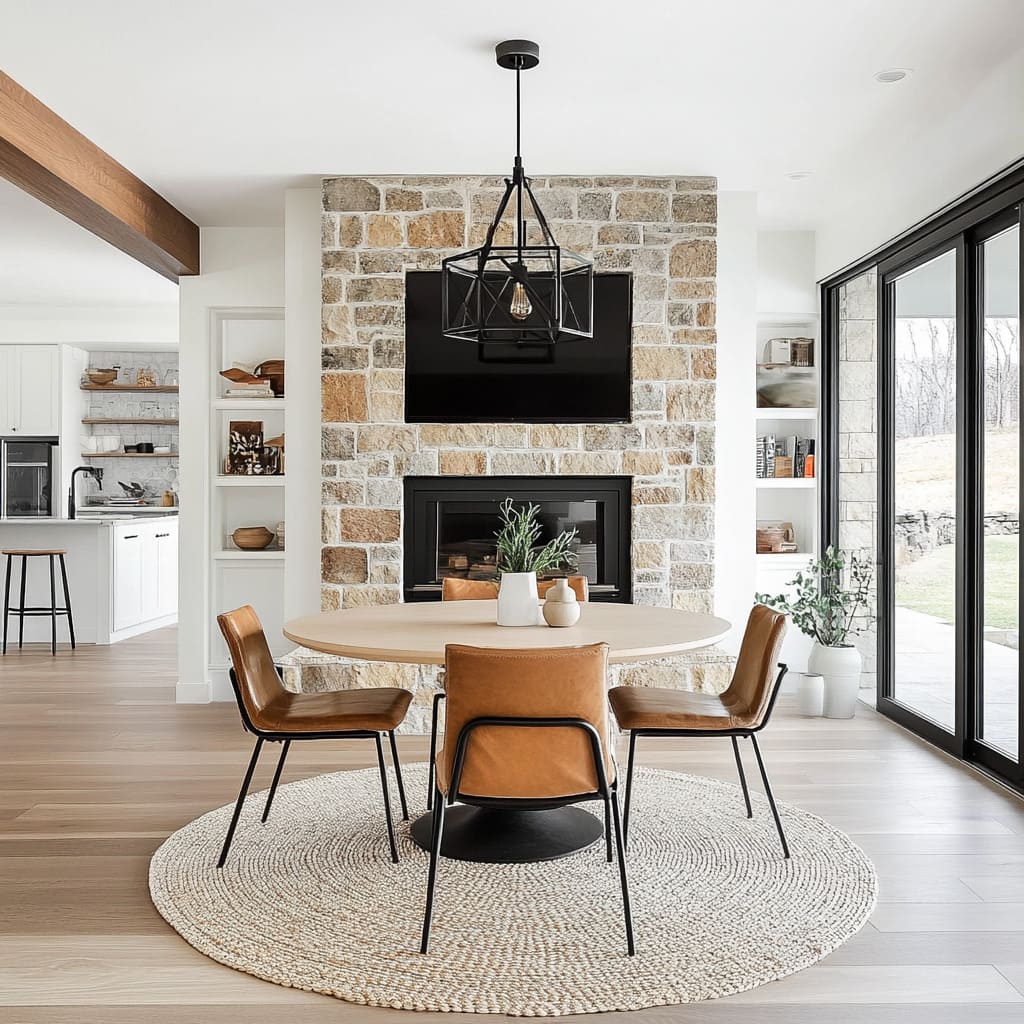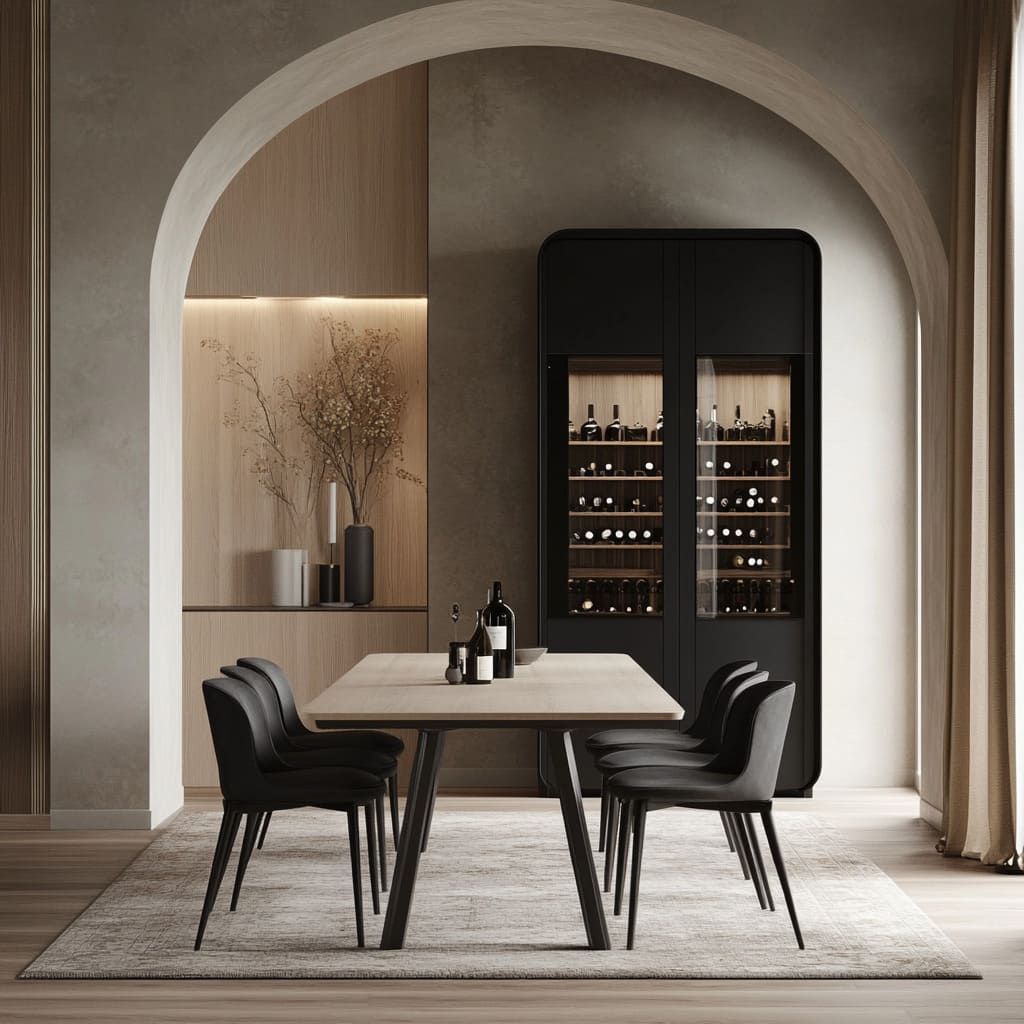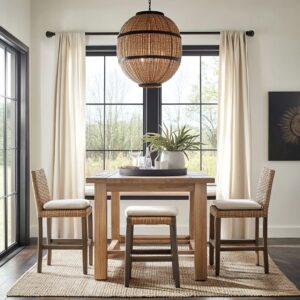Is your dining room starting to feel outdated or uninspired? Bringing in fresh design ideas can completely transform the space, making it a more inviting and functional centerpiece of your home.
From bold modern dining room ideas to elements that add warmth and texture, creating a stylish dining area is easier than you might think. Modern dining rooms today strike a balance between aesthetics and practicality, blending clean lines, natural materials, and thoughtful lighting.
Whether you’re drawn to the rich contrast of dark wood tables or the airy feel of Scandinavian-inspired spaces, this guide offers insight into the key elements that make a dining room truly stand out. These concepts are perfect for American homes of all shapes and sizes, offering versatile solutions that suit various lifestyles.
Let’s take a closer look at how thoughtful design choices—from the dining table to lighting—can transform your space into a modern masterpiece.
The Modern Dining Table as the Centerpiece
A dining table is more than just a functional piece of furniture; it’s the anchor of the entire room. Whether you’re hosting dinner parties, enjoying family meals, or simply sipping coffee on a quiet morning, the right table sets the tone for everything that happens in the space.
Selecting the right table is essential for achieving a balance between style and practicality, making it the natural starting point for modern dining room ideas.
Materials That Speak to Style and Warmth
The materials you choose for your dining table can define the atmosphere of the room. A pale oak table introduces warmth and lightness, making the space feel welcoming yet modern.
On the other hand, darker finishes, such as rich walnut or espresso-stained wood, create striking contrasts and add an element of sophistication. Pairing these materials with complementary furniture, such as upholstered chairs or woven accents, ensures the room feels cohesive and intentional.
Shapes That Influence Space and Comfort
The shape of your dining table plays a crucial role in determining how the space functions. Rectangular tables are perfect for larger dining areas, providing ample seating while maintaining a sense of order.
Alternatively, round tables are ideal for cozier settings, fostering a more intimate and conversational atmosphere. Their circular shape softens the room’s geometry and pairs well with modern, clean layouts.
Functionality as the Heart of Design
A dining table isn’t just about how it looks—it’s about how it works for your lifestyle. Whether you’re drawn to extendable tables for flexibility or fixed designs that offer stability, the functionality of your table should enhance your day-to-day life.
A well-chosen table can act as a unifying element, bringing together the surrounding decor and creating a sense of balance in the room.
Examples to Inspire Your Space
Imagine a pale wood rectangular table paired with sleek black chairs, evoking the minimalist charm of Scandinavian interiors. Alternatively, a round wooden table with a bold black base makes a statement while embracing simplicity.
Pair it with oversized woven pendants or geometric chandeliers for a dining room that’s both stylish and functional. By prioritizing the right table for your space, you’ll lay the foundation for a dining room that feels thoughtfully designed and inviting—perfect for both intimate meals and lively gatherings.
Chairs That Blend Comfort with Aesthetics
The dining chairs you choose are more than just a place to sit—they play a significant role in the room’s overall look and feel. A perfect chair not only complements the table but also adds character and ensures comfort for everyone gathered around.
Upholstered Chairs for a Luxurious Touch
For those who love comfort with a hint of sophistication, upholstered chairs are an excellent choice. Opt for materials in soft, neutral tones like light beige, or bring a pop of vibrancy with mustard-yellow upholstery.
These chairs not only offer plush seating but also introduce texture that softens the dining room’s overall appearance.
Woven Chairs for a Rustic Charm
If you’re drawn to a mix of natural and modern influences, woven chairs might be the ideal fit. With their artisanal look, they bring a rustic vibe to the dining room while remaining sleek enough for a refined feel.
These chairs are great for dining rooms inspired by coastal or bohemian styles, offering a tactile element that sets them apart.
Black Modern Chairs for Bold Contrast
For a statement that leans toward contemporary design, black chairs are a foolproof option. With their sleek lines and timeless appeal, they add boldness to the space without overwhelming it.
When paired with lighter wood or neutral decor, black chairs create a dramatic visual contrast.
Examples of Perfect Pairings
Picture black woven chairs alongside a warm, natural wood table for depth and balance, bridging rustic charm with contemporary design. Alternatively, light wooden frames with soft fabric seats create a cozy feel, perfect for Scandinavian-inspired spaces.
By blending style with functionality, the right chairs can bring new energy and cohesion to your dining space.
Lighting: The Design Game-Changer
Lighting has the power to completely transform a dining room, creating the mood and highlighting the space’s best features. Whether you’re dining with family or hosting guests, lighting is more than a functional element—it’s the finishing touch that ties the room together.
Thoughtful lighting choices can enhance your space and work seamlessly with modern dining room wall decor to boost its overall appeal.
Pendant Lights to Anchor the Room
Pendant lights are a popular choice for modern dining spaces because they naturally draw the eye and anchor the table below. Oversized woven pendants introduce a warm, inviting glow, perfect for dining rooms that embrace natural textures and organic designs.
Alternatively, geometric chandeliers bring a contemporary vibe with their clean lines and unique forms, serving as an architectural focal point.
Material Choices That Make a Statement
The materials you choose for your lighting fixtures can set the tone for the entire dining room. Gold finishes add a luxurious touch, especially in rooms featuring dark wood or bold accent colors.
Woven textures bring an earthy quality, creating a more relaxed yet sophisticated atmosphere. Glass shades, whether clear or frosted, offer timeless versatility, blending effortlessly with modern and transitional designs.
Placement Tips for Balanced Illumination
Proper placement is essential to make your lighting work. Hanging your pendant light or chandelier directly above the dining table ensures a balanced, symmetrical look while providing practical illumination.
Consider the height—fixtures should be low enough to create a cozy ambiance but high enough to avoid obstructing the view across the table.
Examples of Lighting in Action
A large woven pendant pairs beautifully with a rustic-modern dining room, adding texture and warmth while highlighting natural tones. In contrast, sleek gold geometric chandeliers can elevate a luxurious dining area, creating a focal point that complements bold, contemporary decor.
Regardless of style, lighting ties everything together, turning your dining area into a space that feels both functional and beautifully designed. By carefully selecting chairs and lighting, you can create a dining room that feels curated and intentional—perfectly suited to the modern home and filled with thoughtful design elements that stand out.
Built-In Bars and Storage: Functional Elegance
The addition of built-in cabinetry in a dining room effortlessly merges function with style, making it a standout feature in any modern space. These elements not only provide valuable storage but also act as a visual anchor that enhances the overall design.
Whether your goal is to display your favorite glassware or create a bold focal point, a well-planned built-in bar transforms your dining room into something truly special.
Open Shelving: Stylish and Practical
Open shelving is an easy way to add a curated, stylish touch to your dining area. By displaying glassware, bar essentials, or small decorative pieces, you can give the room a sense of personality and organization.
For a cohesive look, keep the palette minimal with clear glass or neutral-toned decor, or go bold with colorful accents that stand out against the cabinetry. Open shelving also offers flexibility, allowing you to update the styling seasonally or as your tastes change.
Bold Accents That Define the Space
Adding bold accents to built-in bars transforms them into focal points. A textured backsplash, such as shimmering mosaic tiles, creates a glamorous effect, reflecting light and adding depth.
Alternatively, incorporating dramatic artwork above or within the cabinetry adds personality. Black cabinetry paired with natural wood tones strikes a balance between boldness and warmth, ideal for modern dining areas that blend refinement with an inviting feel.
Integrated Lighting for Added Depth
Lighting plays a key role in showcasing the beauty of your built-ins. Under-cabinet lighting enhances the shimmer of glassware and adds a soft glow for evening ambiance.
Built-in lighting within glass-front cabinets not only highlights the items displayed but also creates a layered and inviting atmosphere. Whether you prefer warm tones for coziness or cooler hues for a modern edge, this detail ensures your storage serves both decorative and functional purposes.
Examples of Built-In Bar Design
A built-in unit with a mosaic tile backsplash and glass-front cabinets exemplifies sophistication. The shimmering effect of the tiles combined with neatly displayed glassware creates a functional yet stunning bar area.
Another standout idea is black cabinetry with natural wood shelving—this mix adds contrast and contemporary flair, especially when paired with modern over-table lighting ideas.
Natural Elements and Textures
Bringing natural materials into your dining room creates a sense of warmth and comfort, turning the space into a welcoming retreat for family and guests. By incorporating textures, organic decor, and wooden finishes, you can achieve a grounded aesthetic that feels timeless and fresh.
Textured Rugs to Define the Space
A textured rug beneath the dining table can instantly transform the room, adding softness while defining the area. Materials like jute offer a rustic feel, while woven wool lends a more polished look.
These rugs not only protect your flooring but also create visual contrast, especially when paired with sleek modern dining decorating ideas. For example, a jute rug under a dark wood table creates a rustic-modern vibe that feels balanced and inviting.
Dried Florals for Organic Elegance
Dried florals are a simple way to bring natural beauty into your space with minimal effort. Neutral arrangements, such as dried grasses or preserved flowers, add texture and charm without overwhelming the design.
Placing these in ceramic vases atop your table or cabinetry creates a timeless centerpiece that works with any modern dining setup. These florals pair beautifully with bold furniture, introducing a softness that offsets sharper design elements.
Wooden Accents for Warmth
Incorporating wooden elements into your dining room—whether through cabinetry, flooring, or furniture—instantly adds coziness. Light-toned wood evokes a Scandinavian-inspired feel, while darker stains bring a traditional or dramatic edge.
These accents blend seamlessly with modern dining room styles, offering a timeless anchor to the space. Wooden shelving within built-ins is another way to introduce natural tones subtly, adding depth and balance.
Examples of Natural Textures in Use
Imagine a dining room with a jute rug grounding a dark, rectangular table, creating a striking contrast that balances rustic and modern styles. Picture a neutral-toned ceramic vase filled with dried grasses as a centerpiece, offering understated elegance.
These touches demonstrate how natural elements can harmonize with bold designs, resulting in a dining space that feels approachable and visually compelling. By combining functional built-ins with natural textures, your dining room becomes more than just a place to eat—it transforms into a beautifully designed, intentional space that inspires and feels complete.
Art and Statement Pieces
Art has the power to elevate a dining room from functional to inspiring. It creates visual interest, adds personality, and can set the mood for every meal shared in the room.
Choosing the right statement pieces allows you to reflect your style while tying together the room’s design elements. Whether bold or understated, art can transform your dining space into a stylish environment.
Abstract Art for Dynamic Energy
Abstract art is an excellent choice for adding energy to your dining room. Bold, vibrant pieces introduce movement and color, drawing the eye and becoming a dynamic focal point.
These works are especially impactful in dining rooms with minimalist furniture, as the clean lines of the furniture let the art stand out. Abstract art complements modern dining table ideas, offering an expressive balance to functional designs.
h3>Subtle Tones for a Minimalist Approach.
For dining rooms with a minimalist or neutral aesthetic, consider art with soft tones that blend harmoniously with the space. Subtle pieces, such as abstract lines or watercolors, add texture and depth without overpowering the room. These choices help create a calming, cohesive atmosphere, particularly in homes with light wood finishes and neutral palettes.
Placement Matters
The positioning of your art plays a significant role in the room’s balance. Hanging a statement piece above a buffet or console creates a natural focal point that anchors the layout.
Feature walls are another excellent choice for large, attention-grabbing works. For symmetry and flow, ensure the placement complements the room’s overall design.
Examples of Art in Dining Rooms
A bold black-and-white abstract painting above a buffet adds a modern edge while maintaining a clean palette. For vibrancy, colorful geometric art placed above a built-in bar serves as a focal point, enhancing modern dining room wall decor while unifying surrounding design elements.
Art brings character and energy to your dining space, making it an engaging environment that goes beyond functionality.
Color Palette and Contrast
Color is one of the most important factors in shaping the mood of your dining room. The right palette can make the space feel warm, inviting, or sophisticated, while strategic contrasts add depth and interest.
Whether you prefer subtle tones or bold statements, the use of color has the potential to redefine the character of your dining space.
Neutral Foundations for Timeless Appeal
Starting with a neutral base—like beige, white, or light wood—lays the groundwork for a dining room that feels timeless and versatile. These shades create a clean and airy backdrop, allowing other design elements to stand out.
Neutral tones are especially popular in contemporary dining rooms, offering the perfect balance between simplicity and style. A dining table with pale wood paired with neutral decor creates a calm and polished look that’s easy to accessorize.
Bold Contrasts for Visual Drama
If your goal is to make a statement, incorporating bold contrasts can completely change the energy of the room. Black furniture or cabinetry against lighter walls creates striking visual depth and brings a sense of sophistication.
These contrasts also highlight other design details, like metallic lighting or textured rugs, allowing the room to feel layered and intentional. For dining areas, black accents work seamlessly with modern kitchen dining room ideas, adding sleekness to shared spaces.
Pops of Color to Bring the Room to Life
Adding color is a fantastic way to personalize your dining room. Chairs in mustard yellow or cushions in deep green provide cheerful accents that brighten the space without overwhelming it.
Warm hues, such as rust or terracotta, also introduce a cozy, welcoming vibe that’s perfect for family gatherings or dinner parties. These small yet impactful touches bring personality to the room, making it feel more dynamic and inviting.
Examples of Color and Contrast
Picture a dining room with mustard-yellow chairs surrounding a black table—this combination feels bold and cheerful, creating a lively atmosphere for entertaining. In another setting, black cabinetry paired with warm wood flooring adds contrast that feels both sleek and grounded, ideal for spaces inspired by modern dining decorating ideas.
By balancing neutral tones, bold contrasts, and pops of color, your dining room can achieve a sense of harmony that feels uniquely yours. These thoughtful choices in art and color allow your dining room to reflect your personality while staying on-trend, creating a space that’s not only functional but truly enjoyable to spend time in.
Maximizing Natural Light
Natural light has an undeniable ability to enhance the atmosphere of any dining room, making it feel more open, warm, and inviting. Thoughtful use of daylight doesn’t just brighten the space; it brings out the textures, colors, and design details that make your dining area special.
Incorporating strategies to maximize natural light will give your dining room a fresh and modern appeal while keeping it practical for everyday use.
Large Windows for a Modern Statement
Floor-to-ceiling windows are one of the most impactful ways to bring natural light into a dining room. Black-framed windows, in particular, add a contemporary edge, creating bold outlines that frame outdoor views like artwork.
These windows not only flood the space with daylight but also serve as a design feature that complements modern and minimalist interiors. The sharp contrast of black frames against lighter walls emphasizes the open feel, making them a standout choice for contemporary dining room design ideas.
Sheer Curtains to Soften Light
For those who value a balance between brightness and privacy, sheer curtains are the perfect solution. Light, translucent fabrics diffuse harsh sunlight, bathing the room in a soft glow while preserving your view.
Sheer white curtains, for example, introduce an understated elegance, blending seamlessly with most decor styles. They pair beautifully with natural textures like wood and woven accents, maintaining the room’s airy, open feel without competing for attention.
Layout Tips to Make the Most of Daylight
The placement of your dining table can significantly impact how light interacts with the space. Positioning the table near large windows ensures it becomes a focal point under the natural light, enhancing its materials and finishes.
This layout works especially well for homes with scenic outdoor views, creating a harmonious connection between the dining room and its surroundings. For smaller spaces, mirrors can amplify incoming daylight, reflecting it throughout the room and making it feel larger.
Examples of Light-Filled Dining Spaces
Imagine a dining room with floor-to-ceiling windows framing lush outdoor greenery—this setup not only maximizes daylight but also brings nature into the space. Alternatively, a dining area with sheer white curtains allows soft, natural light to filter in, creating a bright and welcoming atmosphere.
These design approaches ensure your dining room feels fresh and inviting at any time of day.
Mixing Traditional and Modern Styles
Blending traditional and modern styles in a dining room creates a unique aesthetic, combining the warmth of classic design with the clean lines of contemporary elements. This fusion provides greater flexibility in expressing your style while maintaining a cohesive and visually engaging space.
Thoughtful integration of textures, finishes, and decor achieves a balanced look that feels both timeless and current.
Rustic Meets Modern
An easy way to merge these styles is by combining contrasting textures. Pairing rustic woven elements with sleek, modern furniture creates a dynamic contrast that feels balanced.
A woven pendant light over a contemporary dining table adds warmth while maintaining a modern edge. These textures complement each other, creating a space that feels both grounded and stylish, perfect for homes with diverse influences.
Elegant Finishes for Timeless Appeal
Gold or brass accents effectively bridge traditional and modern styles. Whether in lighting fixtures, decorative hardware, or table accents, these finishes bring sophistication that works across design eras.
For instance, gold accents paired with dark cabinetry or modern black dining chairs create a seamless connection between old and new elements.
Minimalist Touches to Keep It Clean
While layering styles is important, keeping decor simple ensures that each element stands out without overwhelming the room. Minimalist touches, such as clean-lined furniture and understated wall art, help maintain a modern aesthetic.
Highlighting one or two statement pieces—like a textured centerpiece or bold rug—creates a design that feels intentional and polished.
Examples of Blended Styles in Action
Picture a dining room where a rustic woven pendant hangs above a sleek black dining table. The mix of natural and modern materials adds depth and balance to the space.
Another example is a textured area rug grounding a contemporary dining set, creating a cozy yet clean foundation. These thoughtful combinations illustrate how mixing traditional and modern styles creates spaces that feel familiar yet forward-thinking.
By embracing natural light and blending traditional with modern elements, your dining room becomes a space that balances comfort with style. Whether inspired by contemporary dining tables or timeless rustic details, you can design a room that feels uniquely yours.
Conclusion
A modern dining room isn’t just a place to eat—it’s where design meets practicality, creating a space that feels both inviting and stylish. This guide explored how thoughtful design elements come together to transform dining areas into functional works of art.
Statement-making tables set the tone, while bold lighting enhances the mood. Functional storage, like built-in cabinetry, blends utility with aesthetics, providing a refined backdrop for gatherings.
Natural accents, such as textured rugs and organic decor, introduce warmth, and carefully chosen art pieces infuse energy or calm, depending on your preferences.
By incorporating bold contrasts, soft textures, and natural light, you can create a space that looks beautiful and works seamlessly for everyday living. For inspiration, browsing contemporary dining room designs offers countless ideas to personalize your space while embracing modern aesthetics.
Ultimately, your dining room should reflect your lifestyle—a place where function meets personality and every meal becomes an occasion. With these tips, you’ll design a space that combines comfort and contemporary flair, perfectly tailored to your home.
